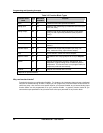
Programming and Operating Concepts
Video Recorder – User Manual 49
3.9 Definition of Function Blocks
Definition
A function block is a unit of software that performs a set of operations on its input parameters and
function block parameters and produces output parameters. These output parameters can be
programmed as inputs to other function blocks, whose output parameters can be programmed as inputs
to other function blocks, and so on. By programming all desired function blocks' input parameters and
function block parameters, you configure the instrument to measure and control your process.
Types of function blocks
Each function block performs a set of operations which fulfills a unique purpose. For example, the
Analog Input function blocks processes the analog input data, the alarm function block processes
alarms, and so on.
Table 3-3 describes each function block.
Some function blocks—namely, Analog Input, Analog Output, Discrete Input, and Discrete Output—
interface with the hardware; that is, they are the link between the instrument and the input or output
hardware. The Analog Input and Discrete Input function blocks convert the incoming process data (like
the process variable or any discrete on/off signals from a switch) into information usable by the
instrument. This incoming information is processed according to the entire function block configuration in
the instrument, and it is ultimately passed on to the output function blocks. The Analog Output and
Discrete Output function blocks convert this output information into a voltage or current which is fed to
the corresponding output hardware (like a current output or relay).
Other function blocks are not directly “seen” by the hardware; they are purely software. They can be
thought of as the middle of the process described in the previous paragraph. For example, a Standard
Splitter Calculated Value can split a control loop’s output into 2 values: one for heating and one for
cooling. These 2 values can be passed on to the Analog Output function block which ultimately controls
the amount of output current or voltage.
Flow of information
The “flow” of information— from the input hardware to the input function blocks to the function block
configuration to the output function blocks to the output hardware—can be likened to a river flowing from
upstream to downstream. In some cases, like with a control loop’s feedback, this analogy is not true
because the information is flowing in a circle, but it is a helpful way to view how function blocks are
generally interconnected. For example, the Analog Input function block is typically upstream of the
Control Loop function, which is typically upstream of the Analog Output function block. Of course, if two
function blocks are not directly or indirectly connected, there is no flow between the two. Just remember
that every function block has input, does a set of operations, and produces an output. When several
function blocks are linked together, there is a flow of information.


















